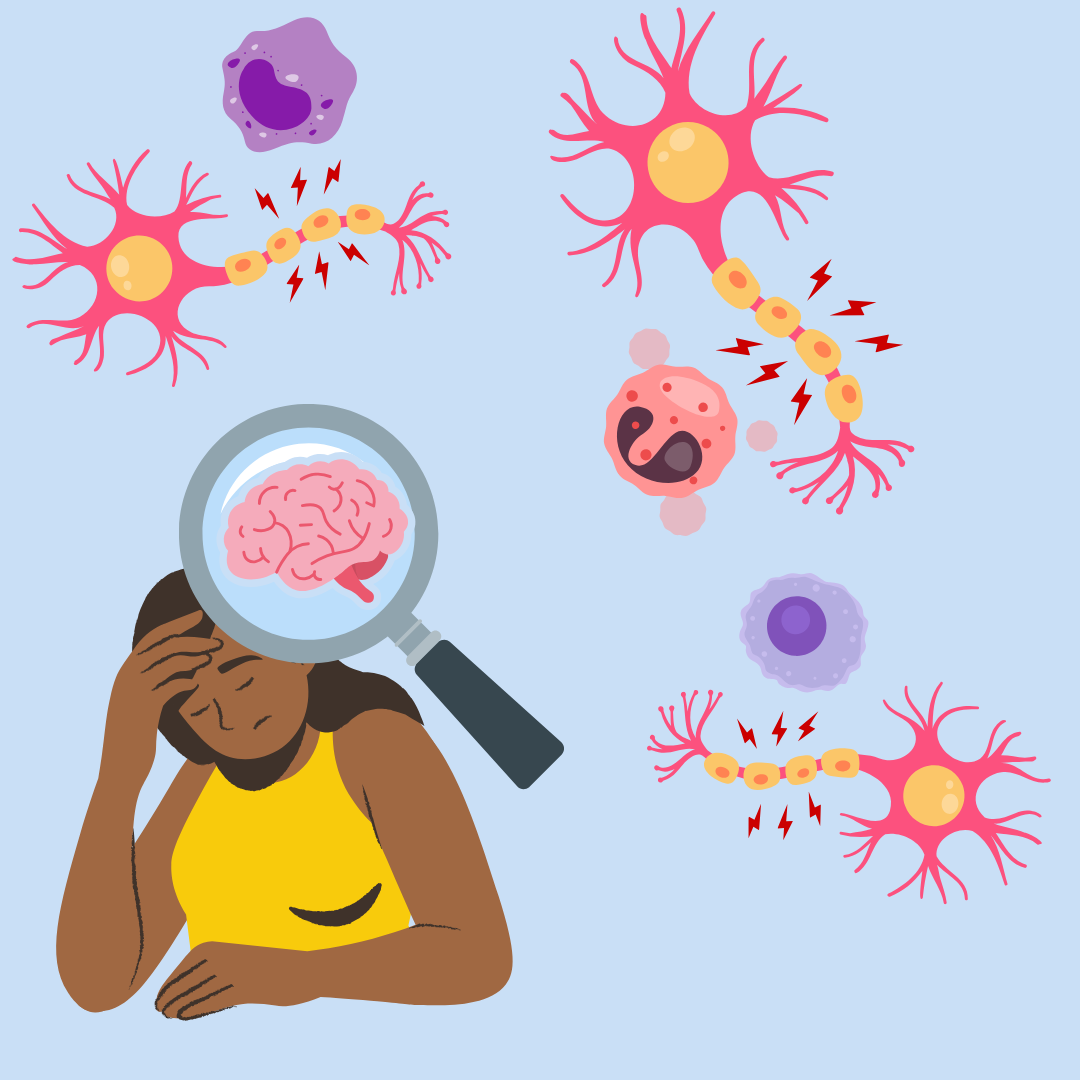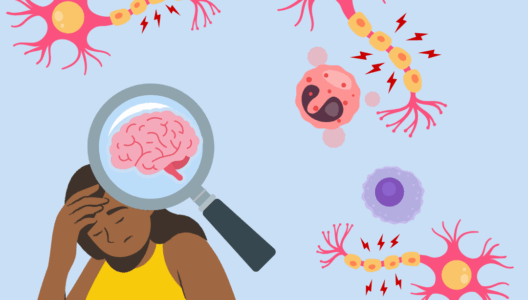The relationship between pain and Multiple Sclerosis
Everyone has experienced pain at least once in their life, whether trying to remove a hot meal from the oven or stubbing their toe on the couch. Pain is a part of everyday life for many people living with MS, and it is usually more than just a singular feeling (Solaro et al., 2013). Pain can present as a combination of emotional and physical symptoms, which are influenced by an individual’s biology, environment, personal relationships, or even the time of day.
In MS, immune cells in the brain and spinal cord can damage or “eat away” the lining or “protective layer” on nerve cells, also known as “myelin”. This phenomenon causes inflammation, which may disrupt or amplify signals that inform your brain that you are feeling pain, even when you cannot identify a specific event or injury (Truini et al., 2013).
Immune cells can also send messages that activate pain pathways, which means that your system can send signals that tell your body to feel pain and to inform your system that something is happening (Solaro et al., 2013). This increased activation of nerve cells is called pain sensitivity, namely, you are susceptible to pain and the “threshold” that your system requires to feel pain lowers. Think of your pain threshold like a heavy door and the feeling of pain as the door opening; it typically takes quite a lot of force to open, but if you have heightened pain sensitivity, even a small tap can send the door swinging wide. This means that for people with increased pain sensitivity, pain can be caused by small stimuli that would typically not be painful.
Why is it important to communicate about your pain?
Pain is not always bad! It can warn our body when we are experiencing an injury to move away from something that might be causing harm, also known as acute pain. Chronic pain can develop when constant inflammation occurs and pain symptoms persist longer than useful, often after injury (Mills et al., 2019). These recurring pain signals are more harmful than adaptive for the body and can impact physical, psychological, and social aspects of everyday life (Mills et al., 2019).
Clinicians and researchers often categorize MS pain based on individuals’ reported symptoms (O’Connor et al., 2008). The description of pain can help clinicians provide practical guidance for formulating appropriate treatment plans (Truini et al., 2013).The main types of MS-related pain are defined as neuropathic pain (burning, tingling, or electric shocks), musculoskeletal pain (deeper aching, stiffness, or a dull, throbbing sensation), and mixed pain (when more than one symptom is involved).
For example, neuropathic pain occurs when inflammation can damage nerves and heighten pain sensitivity. When there is a lot of damage to the nerves, this can cause more intense pain symptoms and lead to chronic pain (Mirabelli & Elkabes, 2021). Feeling more than one type of pain is common, and each person’s experience is unique. Describing your pain type, location, and variability may be important when communicating with clinicians. Pain can also change based on time of day, and this is what our team at CircaMS is interested in. Recording how your pain changes throughout the day is also important to understand how your symptoms impact your ability to complete activities of daily living, engage in personal relationships, or even your performance at work (Kratz et al., 2017).
A Short Takeaway
A clear picture of how inflammation creates various pain experiences can help individuals understand their pain better. Using simple, everyday descriptions can guide clinicians. Our team of researchers want to better understand how changes in pain impact the duration and intensity of symptoms. If you are interested in finding out more, click this link to learn about the CircaMS study.
For more information about pain or MS, click on the links below.
Written by Andy B.
References
Kratz, A. L., Braley, T. J., Foxen-Craft, E., Scott, E., Murphy, J. F., & Murphy, S. L. (2017). How Do Pain, Fatigue, Depressive, and Cognitive Symptoms Relate to Well-Being and Social and Physical Functioning in the Daily Lives of Individuals With Multiple Sclerosis? Archives of Physical Medicine and Rehabilitation, 98(11), 2160–2166. https://doi.org/10.1016/j.apmr.2017.07.004
Mills, S. E. E., Nicolson, K. P., & Smith, B. H. (2019). Chronic pain: A review of its epidemiology and associated factors in population-based studies. British Journal of Anaesthesia, 123(2), e273–e283. https://doi.org/10.1016/j.bja.2019.03.023
Mirabelli, E., & Elkabes, S. (2021). Neuropathic pain in multiple sclerosis and its animal models: focus on mechanisms, knowledge gaps and future directions. Frontiers in Neurology, 12, 793745. https://doi.org/10.3389/fneur.2021.793745
O’Connor, A. B., Schwid, S. R., Herrmann, D. N., Markman, J. D., & Dworkin, R. H. (2008). Pain associated with multiple sclerosis: systematic review and proposed classification. Pain, 137(1), 96–111. https://doi.org/10.1016/j.pain.2007.08.024 (ScienceDirect abstract: https://www.sciencedirect.com/science/article/abs/pii/S0304395907004605.
Solaro, C., Trabucco, E., & Messmer Uccelli, M. (2013). Pain and Multiple Sclerosis: Pathophysiology and Treatment. Current Neurology and Neuroscience Reports. https://link.springer.com/article/10.1007/s11910-012-0320-5.
Truini, A., Barbanti, P., Pozzilli, C., & Cruccu, G. (2013). A mechanism-based classification of pain in multiple sclerosis. Journal of Neurology, 260, 351–367. https://www.ncbi.nlm.nih.gov/pmc/articles/PMC3566383/


